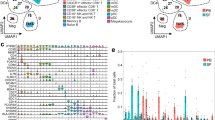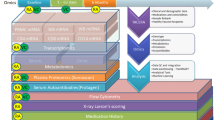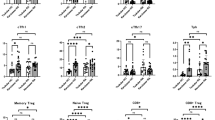Abstract
Reactive arthritis (ReA), an inflammatory arthritic condition that is commonly associated with Chlamydia infections, represents a significant health burden, yet is poorly understood. The enigma of this disease is reflected in its problematic name and in its ill-defined pathogenesis. The existence of persistent pathogens in the arthritic joint is acknowledged, but their relevance remains elusive. Progress is being made in understanding the underlying mechanisms of ReA, whereby an imbalance between type 1 and type 2 immune responses seems to be critical in determining susceptibility to disease. Such an imbalance occurs prior to the initiation of an adaptive immune response, suggesting that innate cellular and molecular mechanisms in ReA should be prioritized as fruitful areas for investigation.
This is a preview of subscription content, access via your institution
Access options
Subscribe to this journal
Receive 12 print issues and online access
$189.00 per year
only $15.75 per issue
Buy this article
- Purchase on SpringerLink
- Instant access to full article PDF
Prices may be subject to local taxes which are calculated during checkout


Similar content being viewed by others
References
Rich, E., Hook, E. W. 3rd, Alarcón, G. S. & Moreland, L. W. Reactive arthritis in patients attending an urban sexually transmitted diseases clinic. Arthritis Rheum. 39, 1172–1177 (1996).
Sieper, J. Pathogenesis of reactive arthritis. Curr. Rheumatol. Rep. 3, 412–418 (2001).
Carter, J. D. & Hudson, A. P. The evolving story of Chlamydia-induced reactive arthritis. Curr. Opin. Rheumatol. 22, 424–430 (2010).
Gérard, H. C., Whittum-Hudson, J. A., Carter, J. D. & Hudson, A. P. The pathogenic role of Chlamydia in spondyloarthritis. Curr. Opin. Rheumatol. 22, 363–367 (2010).
Carter, J. D. et al. Chlamydiae as etiologic agents in chronic undifferentiated spondylarthritis. Arthritis Rheum. 60, 1311–1316 (2009).
Söderlin, M. K., Kautiainen, H., Skogh, T. & Leirisalo-Repo, M. Quality of life and economic burden of illness in very early arthritis. A population based study in Southern Sweden. J. Rheumatol. 31, 1717–1722 (2004).
Keat, A. et al. Chlamydia trachomatis and reactive arthritis: the missing link. Lancet 1, 72–74 (1987).
Brunham, R. C. & Peeling, R. W. Chlamydia trachomatis antigens: role in immunity and pathogenesis. Infect. Agents Dis. 3, 218–233 (1994).
Stephens, R. S. The cellular paradigm of chlamydial pathogenesis. Trends Microbiol. 11, 44–51 (2003).
Nanagara, R., Li, F., Beutler, A., Hudson, A. & Schumacher, H. R. Jr. Alteration of Chlamydia trachomatis biologic behavior in synovial membranes. Suppression of surface antigen production in reactive arthritis and Reiter's syndrome. Arthritis Rheum. 38, 1410–1417 (1995).
Carter, J. D. et al. Combination antibiotics as a treatment for chronic Chlamydia-induced reactive arthritis: a double-blind, placebo-controlled, prospective trial. Arthritis Rheum. 62, 1298–1307 (2010).
Tarkowski, A. Infection and musculoskeletal conditions: infectious arthritis. Best Pract. Res. Clin. Rheumatol. 20, 1029–1044 (2006).
Mathews, C. J., Weston, V. C., Jones, A., Field, M. & Coakley, G. Bacterial septic arthritis in adults. Lancet 375, 846–855 (2010).
Moazed, T. C., Kuo, C. C., Grayston, J. T. & Campbell, L. A. Evidence of systemic dissemination of Chlamydia pneumoniae via macrophages in the mouse. J. Infect. Dis. 177, 1322–1325 (1998).
Cotter, T. W., Ramsey, K. H., Miranpuri, G. S., Poulsen, C. E. & Byrne, G. I. Dissemination of Chlamydia trachomatis chronic genital tract infection in gamma interferon gene knockout mice. Infect. Immun. 65, 2145–2152 (1997).
Ng, C. T. et al. Synovial tissue hypoxia and inflammation in vivo. Ann. Rheum. Dis. 69, 1389–1395 (2010).
Roth, A. et al. Hypoxia abrogates antichlamydial properties of IFN-γ in human fallopian tube cells in vitro and ex vivo. Proc. Natl Acad. Sci. USA 107, 19502–19507 (2010).
Rupp, J. et al. Chlamydia pneumoniae directly interferes with HIF-1α stabilization in human host cells. Cell. Microbiol. 9, 2181–2191 (2007).
Shima, K., Szaszák, M., Solbach, W., Gieffers, J. & Rupp, J. Impact of a low-oxygen environment on the efficacy of antimicrobials against intracellular Chlamydia trachomatis. Antimicrob. Agents Chemother. 55, 2319–2324 (2011).
Wyrick, P. B. Chlamydia trachomatis persistence in vitro: an overview. J. Infect. Dis. 201 (Suppl. 2), S88–S95 (2010).
Belland, R. J. et al. Genomic transcriptional profiling of the developmental cycle of Chlamydia trachomatis. Proc. Natl Acad. Sci. USA. 100, 8478–8483 (2003).
Gérard, H. C., Whittum-Hudson, J. A., Schumacher, H. R. Jr & Hudson, A. P. Differential expression of three Chlamydia trachomatis hsp60-encoding genes in active vs. persistent infections. Microb. Pathog. 36, 35–39 (2004).
Droemann, D. et al. Disparate innate immune responses to persistent and acute Chlamydia pneumoniae infection in chronic obstructive pulmonary disease. Am. J. Respir. Crit. Care Med. 175, 791–797 (2007).
Zimmerman, H. L. et al. Epidemiologic differences between chlamydia and gonorrhea. Am. J. Public Health 80, 1338–1342 (1990).
Gerard, H. C. et al. Patients with Chlamydia-associated arthritis have ocular (trachoma), not genital, serovars of C. trachomatis in synovial tissue. Microb. Pathog. 48, 62–68 (2010).
Kari, L. et al. Pathogenic diversity among Chlamydia trachomatis ocular strains in nonhuman primates is affected by subtle genomic variations. J. Infect. Dis. 197, 449–456 (2008).
World Health Organization. Global Prevalence and Incidence of Selected Curable Sexually Transmitted Infections: Overviews and Estimates [online] (2001).
Darville, T. & Hiltke, T. J. Pathogenesis of genital tract disease due to Chlamydia trachomatis. J. Infect. Dis. 201 (Suppl. 2), S114–S125 (2010).
Gottlieb, S. L., Martin, D. H., Xu, F., Byrne, G. I. & Brunham, R. C. Summary: The natural history and immunobiology of Chlamydia trachomatis genital infection and implications for Chlamydia control. J. Infect. Dis. 201 (Suppl. 2), S190–S204 (2010).
Heo, Y., Parsons, P. J. & Lawrence, D. A. Lead differentially modifies cytokine production in vitro and in vivo. Toxicol. Appl. Pharmacol. 138, 149–157 (1996).
Inman, R. D. & Chiu, B. Heavy metal exposure reverses genetic resistance to Chlamydia-induced arthritis. Arthritis Res. Ther. 11, R19 (2009).
Rottenberg, M. E., Gigliotti-Rothfuchs, A. & Wigzell, H. The role of IFN-γ in the outcome of chlamydial infection. Curr. Opin. Immunol. 14, 444–451 (2002).
Inman, R. D. & Chiu, B. Early cytokine profiles in the joint define pathogen clearance and severity of arthritis in chlamydia-induced arthritis in rats. Arthritis Rheum. 54, 499–507 (2006).
Holland, M. J. et al. T helper type-1 (Th1)/Th2 profiles of peripheral blood mononuclear cells (PBMC); responses to antigens of Chlamydia trachomatis in subjects with severe trachomatous scarring. Clin. Exp. Immunol. 105, 429–435 (1996).
Vandooren, B. et al. Absence of a classically activated macrophage cytokine signature in peripheral spondylarthritis, including psoriatic arthritis. Arthritis Rheum. 60, 966–975 (2009).
Smith, J. A. et al. Gene expression analysis of macrophages derived from ankylosing spondylitis patients reveals interferon-γ dysregulation. Arthritis Rheum. 58, 1640–1649 (2008).
Bas, S., Kvien, T. K., Buchs, N., Fulpius, T. & Gabay, C. Lower level of synovial fluid interferon-γ in HLA-B27-positive than in HLA-B27-negative patients with Chlamydia trachomatis reactive arthritis. Rheumatology (Oxford) 42, 461–467 (2003).
Yin, Z. et al. Crucial role of interleukin-10/interleukin-12 balance in the regulation of the type 2 T helper cytokine response in reactive arthritis. Arthritis Rheum. 40, 1788–1797 (1997).
Morrison, S. G., Su, H., Caldwell, H. D. & Morrison, R. P. Immunity to murine Chlamydia trachomatis genital tract reinfection involves B cells and CD4+ T cells but not CD8+ T cells. Infect. Immun. 68, 6979–6987 (2000).
Jiang, X., Shen, C., Yu, H., Karunakaran, K. P. & Brunham, R. C. Differences in innate immune responses correlate with differences in murine susceptibility to Chlamydia muridarum pulmonary infection. Immunology 129, 556–566 (2010).
Nagarajan, U. M. et al. MyD88 deficiency leads to decreased NK cell gamma interferon production and T cell recruitment during Chlamydia muridarum genital tract infection, but a predominant Th1 response and enhanced monocytic inflammation are associated with infection resolution. Infect. Immun. 79, 486–498 (2011).
Bharhani, M. S., Chiu, B., Na, K. S. & Inman, R. D. Activation of invariant NKT cells confers protection against Chlamydia trachomatis-induced arthritis. Int. Immunol. 21, 859–870 (2009).
Barteneva, N., Theodor, I., Peterson, E. M. & De La Maza, L. M. Role of neutrophils in controlling early stages of a Chlamydia trachomatis infection. Infect. Immun. 64, 4830–4833 (1996).
Zhang, X. et al. Innate immunity and arthritis: Neutrophil Rac and Toll-like receptor 4 expression define outcomes in infection-triggered arthritis. Arthritis Rheum. 52, 1297–1304 (2005).
Qiu, H. et al. Type I IFNs enhance susceptibility to Chlamydia muridarum lung infection by enhancing apoptosis of local macrophages. J. Immunol. 181, 2092–2102 (2008).
Iwanaga, T., Shikichi, M., Kitamura, H., Yanase, H. & Nozawa-Inoue, K. Morphology and functional roles of synoviocytes in the joint. Arch. Histol. Cytol. 63, 17–31 (2000).
Jenkins, S. J. et al. Local macrophage proliferation, rather than recruitment from the blood, is a signature of TH2 inflammation. Science 332, 1284–1288 (2011).
Mantovani, A. et al. The chemokine system in diverse forms of macrophage activation and polarization. Trends Immunol. 25, 677–686 (2004).
Manrique, S. Z. et al. Foxp3-positive macrophages display immunosuppressive properties and promote tumor growth. J. Exp. Med. 208, 1485–1499 (2011).
Murray, P. J. & Wynn, T. A. Obstacles and opportunities for understanding macrophage polarization. J. Leukoc. Biol. 89, 557–563 (2011).
Baeten, D. et al. Infiltration of the synovial membrane with macrophage subsets and polymorphonuclear cells reflects global disease activity in spondyloarthropathy. Arthritis Res. Ther. 7, R359–R369 (2005).
Benoit, M., Desnues, B. & Mege, J. L. Macrophage polarization in bacterial infections. J. Immunol. 181, 3733–3739 (2008).
Shirey, K. A., Cole, L. E., Keegan, A. D. & Vogel, S. N. Francisella tularensis live vaccine strain induces macrophage alternative activation as a survival mechanism. J. Immunol. 181, 4159–4167 (2008).
Chen, B., Stout, R. & Campbell, W. F. Nitric oxide production: a mechanism of Chlamydia trachomatis inhibition in interferon-γ-treated RAW264.7 cells. FEMS Immunol. Med. Microbiol. 14, 109–120 (1996).
Kuo, C. C., Puolakkainen, M., Lin, T. M., Witte, M. & Campbell, L. A. Mannose-receptor positive and negative mouse macrophages differ in their susceptibility to infection by Chlamydia species. Microb. Pathog. 32, 43–48 (2002).
Author information
Authors and Affiliations
Contributions
E. Gracey researched data for the article. Both authors contributed equally to discussing the content, writing the article and performing review/editing of the manuscript before submission.
Corresponding author
Ethics declarations
Competing interests
The authors declare no competing financial interests.
Rights and permissions
About this article
Cite this article
Gracey, E., Inman, R. Chlamydia-induced ReA: immune imbalances and persistent pathogens. Nat Rev Rheumatol 8, 55–59 (2012). https://doi.org/10.1038/nrrheum.2011.173
Published:
Issue date:
DOI: https://doi.org/10.1038/nrrheum.2011.173
This article is cited by
-
Reaktive Arthritis – ein Update
Monatsschrift Kinderheilkunde (2021)
-
Time to revisit the concept of reactive arthritis
Nature Reviews Rheumatology (2017)
-
Chronic Chlamydial Diseases: From Atherosclerosis to Urogenital Infections
Current Clinical Microbiology Reports (2014)
-
Chlamydia pneumoniae and osteoporosis-associated bone loss: a new risk factor?
Osteoporosis International (2013)
-
Polymorphism of HLA-B27: 105 Subtypes Currently Known
Current Rheumatology Reports (2013)



